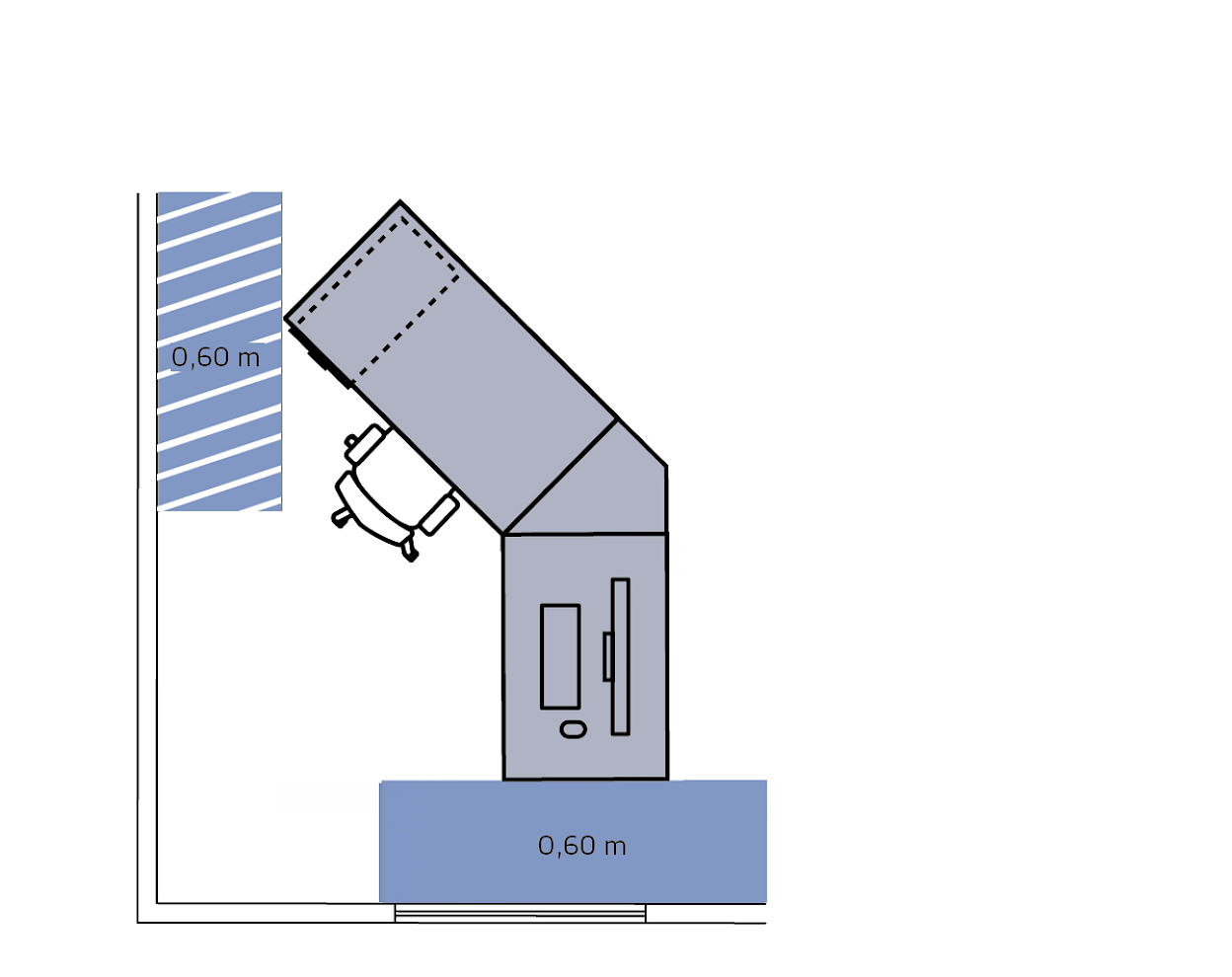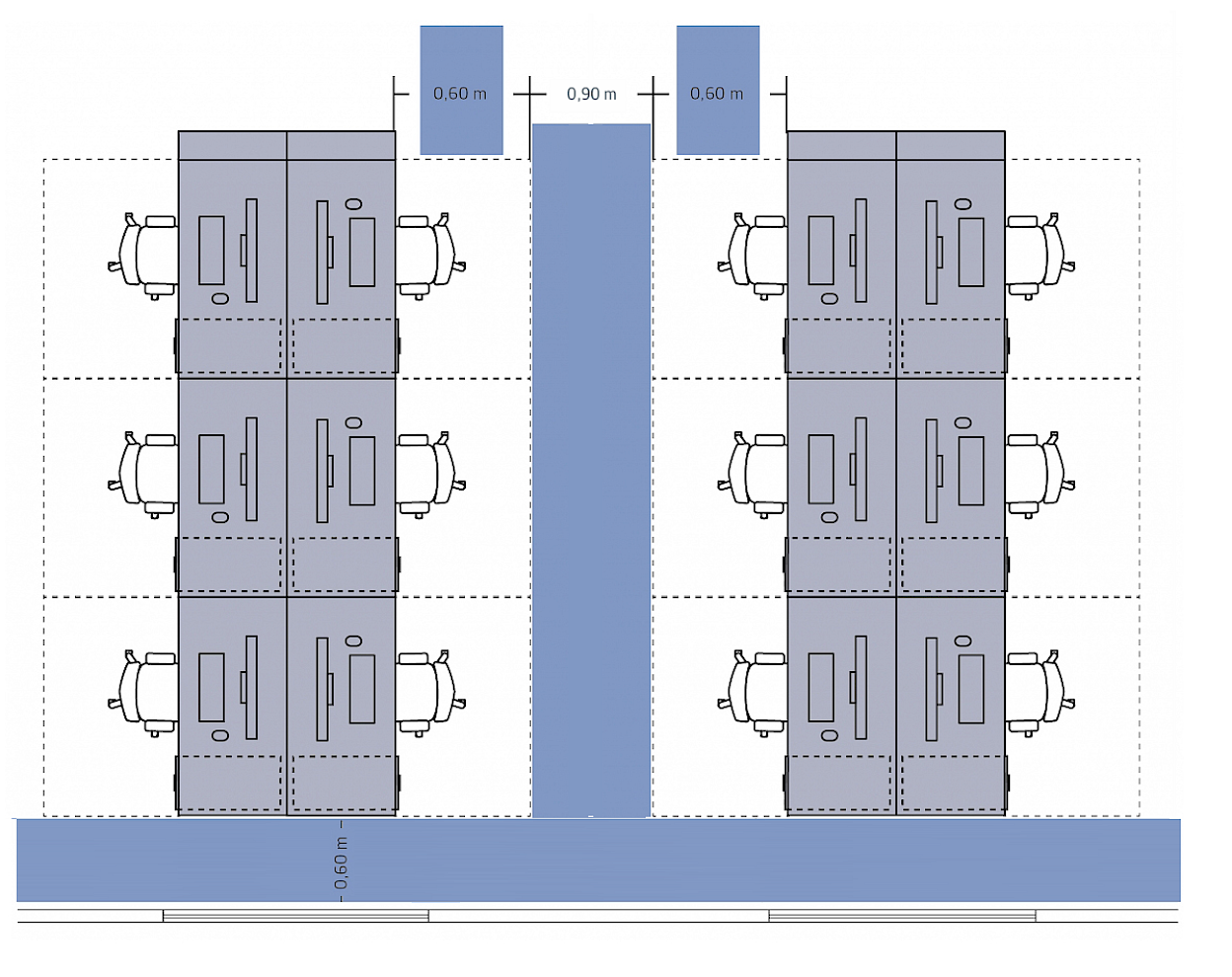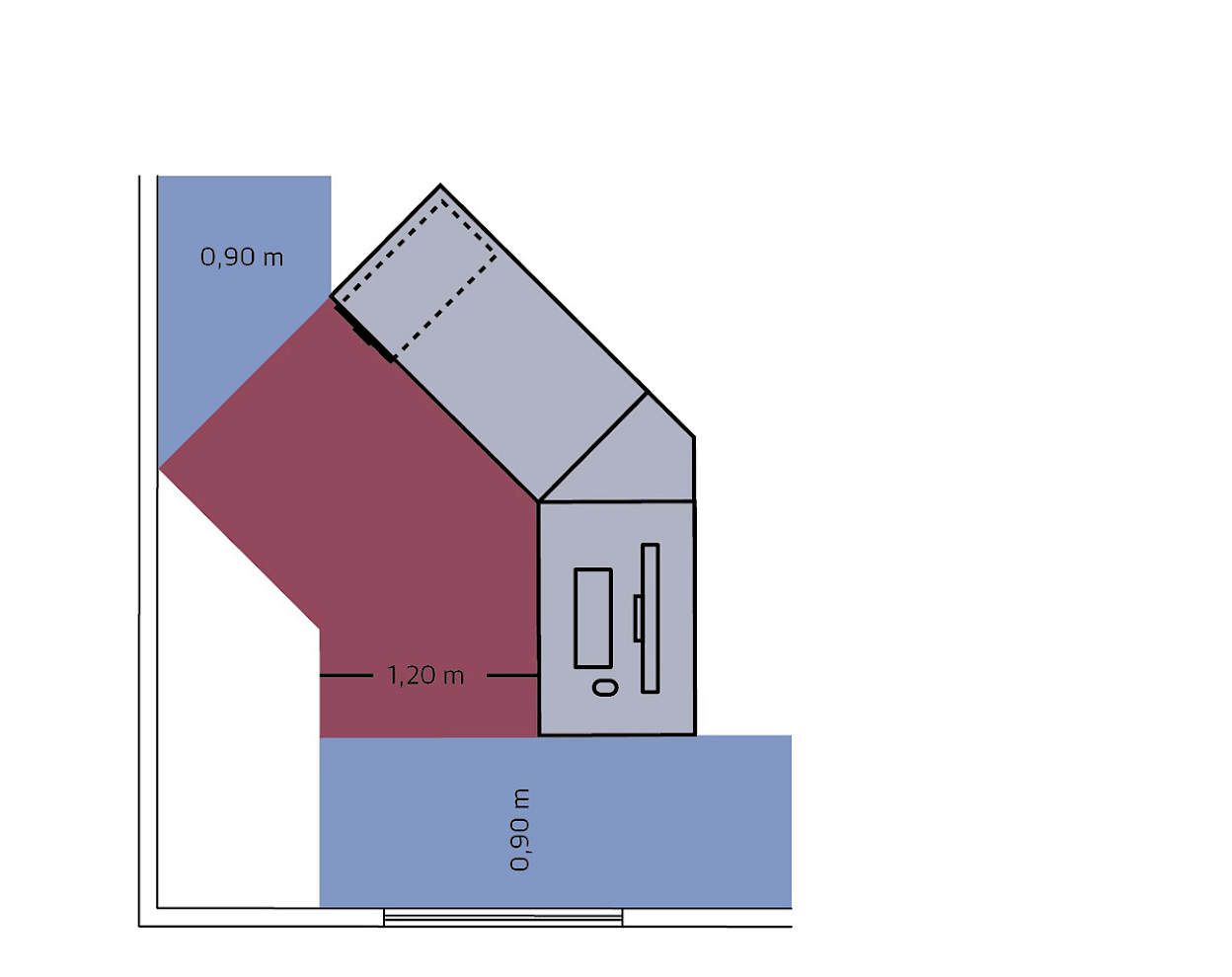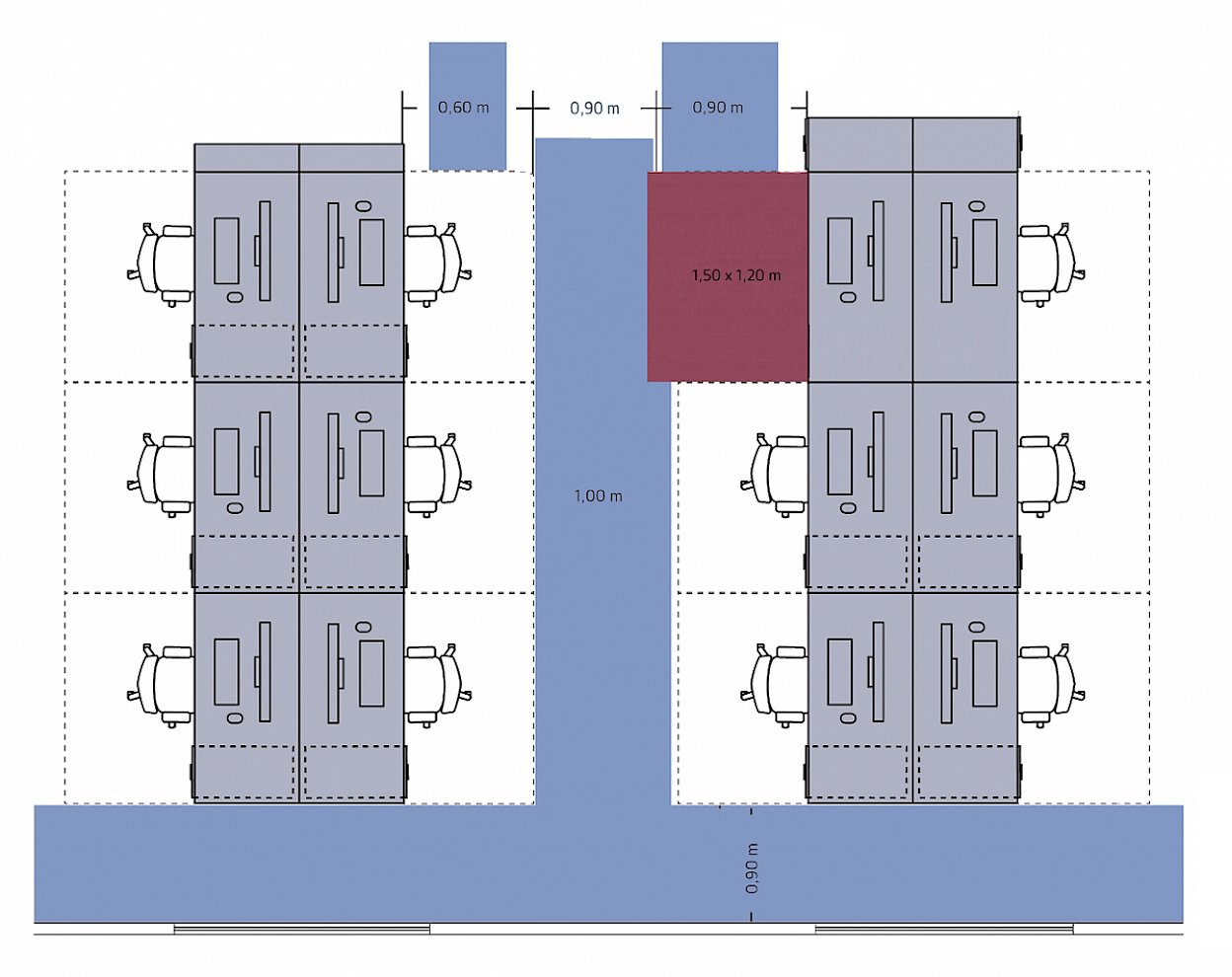Circulation routes provide access to different parts of a workspace. Escape routes are essential for quickly leaving the building in case of emergency. The requirements for these routes are defined in ASR A1.8 “Circulation Routes”, ASR A2.3 “Escape Routes and Emergency Exits”, and the relevant sections of ASR V3a “Accessible Design of Workplaces”. All three sets of regulations were last updated in March 2022. The DGUV Information 215–441 “Office Design” explains when circulation routes may overlap with other areas and when this is not permitted.
All information on this page is based on regulations applicable in Germany. Requirements in other countries may differ.
Widths and Heights
The following table lists minimum requirements for the clear width and height of circulation routes. Values in brackets refer to possible restrictions in the area of passageways and doors.
|
Type of Route |
Width (m) |
Height (m) |
|---|---|---|
|
Requirements for main escape routes Up to 5 people Up to 20 people Up to 50 people Up to 100 people Up to 200 people Up to 300 people Up to 400 people |
0.90 1.00 1.20 1.20 1.20 1.80 2.40 |
2.10 2.10 2.10 2.10 2.10 2.10 2.10 |
|
Circulation routes to personally assigned workstations (formerly: connecting routes) |
0.60 |
2.10 |
|
Circulation routes to operational equipment with no opposing traffic |
0.60 |
2.10 |
|
Routes for maintenance (formerly: maintenance paths) |
0.60 |
1.90 |
|
Circulation routes for pedestrians between |
1.25 |
2.10 |
|
Pedestrian circulation routes in side aisles of storage areas |
0.75 |
2.10 |
|
Doors to single cubicle toilets or WC rooms |
0.55 |
2.10 |
*A reduction of the minimum corridor width by up to 0.15 m at doorways can be disregarded. However, the clear width must not be less than 0.80 m at any point.
Sources: ASR A1.8 and ASR A2.3
PERMISSIBLE EXCEPTIONS
- Widths for circulation and escape routes used by max. 5 people:
In buildings constructed before or with planning permission submitted by 30 September 2022, the minimum width may remain as previously permitted at 0.875 m (0.85 m in the area of doors and passageways). This remains valid until the building is next significantly extended or renovated, or if an accessible design becomes necessary. - Heights for circulation and escape routes:
In existing buildings, a clear height of 2.00 m is permitted for circulation routes. In addition, the clear height may be reduced to 1.95 m in the area of doors. - Heights for maintenance paths:
These may be reduced to a height of 1.80 m in the area of doors and gates. - Widths of WC doors:
In buildings constructed by 30 September 2022 or for which planning permission was submitted by this date, the minimum width of toilet doors or single-toilet washrooms may continue to be 0.50 m. This applies until they are next significantly extended or structurally altered.
PERMISSIBLE OVERLAPS
- Connecting routes may overlap with other areas of the assigned workstation.
- Circulation routes may overlap with user zones of occasionally used cabinets or shelves. Overlaps with functional zones (e.g. drawer extensions) are not allowed.
FURTHER GUIDANCE


FURTHER GUIDANCE
- For areas serving over 200 people, intermediate widths are allowed. “Area” refers to a zone where all occupants use the same main escape route.
- For new builds or conversions, doors should have a minimum width of 0.90 m to ensure wheelchair access.
- In addition, both ASR 2.3 and ASR 1.8 state that when determining the clear widths, all fixtures and fittings – including fire extinguishers, wall projections, door leaves, door frames, etc. – must be taken into account.
Our tip: Incorporate these insights directly into the planning of your ideal office. The IBA OfficePlanner makes it easy. Try out our new online office planning tool today.
Accessibility
To ensure sufficient space for wheelchair users and those with walking aids, wider circulation routes are required:
|
Type of Route |
Width (mm) |
|---|---|
|
Circulation routes for 1 to 5 people, where no other persons can pass in the opposite direction or where a sufficiently large passing area is within sight |
1.00 |
|
Circulation route for 1–5 persons, where opposing pedestrians (no wheelchair/walker) are possible and no nearby passing space exists |
1.50 |
|
Circulation route for 1–5 persons, where opposing traffic includes wheelchair or walker users and no nearby passing space exists |
1.80
|
|
Connecting routes |
0.90 |
|
Maintenance routes and routes to occasionally used equipment |
0.90 |
Source: ASR V3a.2
EXAMPLES


PERMISSIBLE EXCEPTIONS
- Width of circulation routes:
A reduction of 0.10 m at doors is allowed, but the clear width must not be less than 0.90 m.
ADDITIONAL REQUIREMENTS
- Passing areas
Areas where wheelchair users may encounter pedestrians must be at least 1.50 × 1.50 m in size. If two wheelchair users might meet, the passing areas must be at least 1.80 × 1.80 m. - Maintenance routes
If maintenance routes are only accessible from one side (dead ends), a turning area of 1.50 × 1.50 m must be provided for employees who use a wheelchair or walking aid. If this is not possible, the distance that may need to be travelled in reverse must not exceed 3.00 m.
Definitions
- Circulation routes
Areas used for pedestrian or vehicle movement (manual or automated) within workplaces or on construction sites. Includes corridors, aisles, walkways, platforms, stairways, fixed ladders, and loading ramps.
Source: ASR A1.8 - Escape routes
Circulation routes “subject to specific requirements and intended to enable independent escape from a potential danger zone and, as a rule, also to facilitate the rescue of individuals. An escape route begins at any location in the workplace that employees can access during their work or occupy when using ancillary areas, sanitary facilities, canteens, break rooms, on-call rooms, first-aid rooms, or accommodation units.”
Source: ASR A2.3 - Main escape routes (formerly: primary escape routes)
Circulation routes “in particular, required for evacuation, including corridors and stairwells for necessary staircases as prescribed by building regulations, as well as emergency exits.”
Source: ASR A2.3 - Secondary escape routes (formerly: alternative escape routes)
Additional escape routes leading to safety or open air.
Source: ASR A2.3 - Routes to operational equipment without opposing traffic
These are circulation routes “that provide unobstructed access for the use of building services and operational facilities (e.g. heating systems, windows, electrical supply).”
Source: ASR A1.8 - Maintenance paths
This term refers to circulation routes “used exclusively for the maintenance, inspection, repair or improvement of the workplace or fixed work equipment in order to preserve the structural and technical condition.”
Source: ASR A1.8




